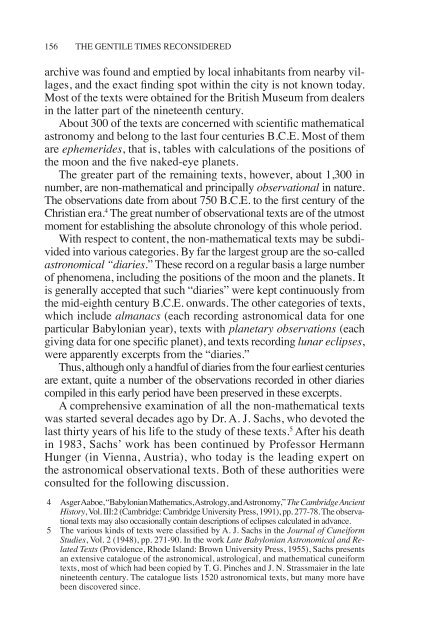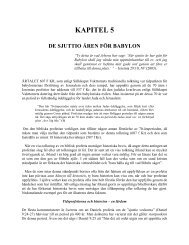4 the absolute chronology of the neo-babylonian era - Kristen Frihet
4 the absolute chronology of the neo-babylonian era - Kristen Frihet
4 the absolute chronology of the neo-babylonian era - Kristen Frihet
Create successful ePaper yourself
Turn your PDF publications into a flip-book with our unique Google optimized e-Paper software.
156 THE GENTILE TIMES RECONSIDERED<br />
archive was found and emptied by local inhabitants from nearby villages,<br />
and <strong>the</strong> exact finding spot within <strong>the</strong> city is not known today.<br />
Most <strong>of</strong> <strong>the</strong> texts were obtained for <strong>the</strong> British Museum from dealers<br />
in <strong>the</strong> latter part <strong>of</strong> <strong>the</strong> nineteenth century.<br />
About 300 <strong>of</strong> <strong>the</strong> texts are concerned with scientific ma<strong>the</strong>matical<br />
astronomy and belong to <strong>the</strong> last four centuries B.C.E. Most <strong>of</strong> <strong>the</strong>m<br />
are ephemerides, that is, tables with calculations <strong>of</strong> <strong>the</strong> positions <strong>of</strong><br />
<strong>the</strong> moon and <strong>the</strong> five naked-eye planets.<br />
The greater part <strong>of</strong> <strong>the</strong> remaining texts, however, about 1,300 in<br />
number, are non-ma<strong>the</strong>matical and principally observational in nature.<br />
The observations date from about 750 B.C.E. to <strong>the</strong> first century <strong>of</strong> <strong>the</strong><br />
Christian <strong>era</strong>. 4 The great number <strong>of</strong> observational texts are <strong>of</strong> <strong>the</strong> utmost<br />
moment for establishing <strong>the</strong> <strong>absolute</strong> <strong>chronology</strong> <strong>of</strong> this whole period.<br />
With respect to content, <strong>the</strong> non-ma<strong>the</strong>matical texts may be subdivided<br />
into various categories. By far <strong>the</strong> largest group are <strong>the</strong> so-called<br />
astronomical “diaries.” These record on a regular basis a large number<br />
<strong>of</strong> phenomena, including <strong>the</strong> positions <strong>of</strong> <strong>the</strong> moon and <strong>the</strong> planets. It<br />
is gen<strong>era</strong>lly accepted that such “diaries” were kept continuously from<br />
<strong>the</strong> mid-eighth century B.C.E. onwards. The o<strong>the</strong>r categories <strong>of</strong> texts,<br />
which include almanacs (each recording astronomical data for one<br />
particular Babylonian year), texts with planetary observations (each<br />
giving data for one specific planet), and texts recording lunar eclipses,<br />
were apparently excerpts from <strong>the</strong> “diaries.”<br />
Thus, although only a handful <strong>of</strong> diaries from <strong>the</strong> four earliest centuries<br />
are extant, quite a number <strong>of</strong> <strong>the</strong> observations recorded in o<strong>the</strong>r diaries<br />
compiled in this early period have been preserved in <strong>the</strong>se excerpts.<br />
A comprehensive examination <strong>of</strong> all <strong>the</strong> non-ma<strong>the</strong>matical texts<br />
was started sev<strong>era</strong>l decades ago by Dr. A. J. Sachs, who devoted <strong>the</strong><br />
last thirty years <strong>of</strong> his life to <strong>the</strong> study <strong>of</strong> <strong>the</strong>se texts. 5 After his death<br />
in 1983, Sachs’ work has been continued by Pr<strong>of</strong>essor Hermann<br />
Hunger (in Vienna, Austria), who today is <strong>the</strong> leading expert on<br />
<strong>the</strong> astronomical observational texts. Both <strong>of</strong> <strong>the</strong>se authorities were<br />
consulted for <strong>the</strong> following discussion.<br />
4 Asger Aaboe, “Babylonian Ma<strong>the</strong>matics, Astrology, and Astronomy,” The Cambridge Ancient<br />
History, Vol. III:2 (Cambridge: Cambridge University Press, 1991), pp. 277-78. The observational<br />
texts may also occasionally contain descriptions <strong>of</strong> eclipses calculated in advance.<br />
5 The various kinds <strong>of</strong> texts were classified by A. J. Sachs in <strong>the</strong> Journal <strong>of</strong> Cuneiform<br />
Studies, Vol. 2 (1948), pp. 271-90. In <strong>the</strong> work Late Babylonian Astronomical and Related<br />
Texts (Providence, Rhode Island: Brown University Press, 1955), Sachs presents<br />
an extensive catalogue <strong>of</strong> <strong>the</strong> astronomical, astrological, and ma<strong>the</strong>matical cuneiform<br />
texts, most <strong>of</strong> which had been copied by T. G. Pinches and J. N. Strassmaier in <strong>the</strong> late<br />
nineteenth century. The catalogue lists 1520 astronomical texts, but many more have<br />
been discovered since.




